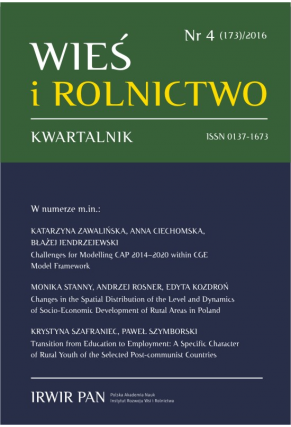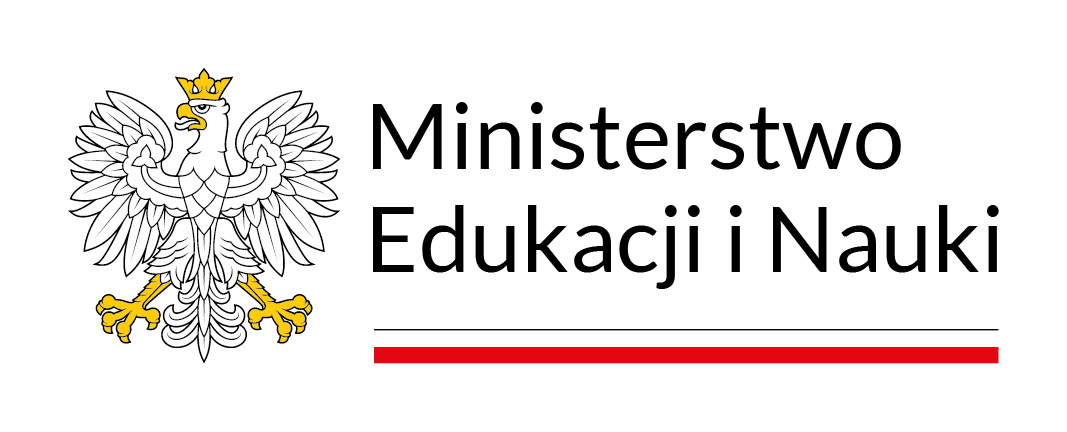Challenges for Modelling CAP 2014–2020 within CGE Model Framework [Wyzwania w odwzorowaniu Wspólnej Polityki Rolnej 2014–2020 w modelach równowagi ogólnej]
DOI:
https://doi.org/10.53098/wir042016/01Słowa kluczowe:
ewaluacja polityki rolnej, modele równowagi ogólnej, modelowanie WPR 2014–2020Abstrakt
Artykuł pokazuje wyzwania związane z modelowaniem ekonomicznych skutków Wspólnej Polityki Rolnej (WPR) z okresu budżetowego 2014–2020 za pomocą modeli równowagi ogólnej (CGE). Modelowanie tak różnorodnej polityki jak WPR z wykorzystaniem modeli CGE nie jest trywialnym zadaniem, co najmniej z trzech powodów. Po pierwsze, wpływa na to duża liczba i zróżnicowanie narzędzi, jakimi posługuje się ta polityka. Już sam filar 2 proponuje ok. 17 działań obwarowanych szczegółowymi wymaganiami. O ile jednak w większości wsparcie w ramach filara 2 jest ukierunkowane – określone są dobra i usługi, na które fundusze te są faktycznie przeznaczane – o tyle środki z filara 1 są wydatkowane przez beneficjentów dowolnie, zatem ocena ich wpływu wymaga dodatkowej wiedzy na temat ich docelowego przeznaczenia. Po drugie, modele CGE wprawdzie odzwierciedlają wszystkie sektory gospodarki, ale w związku z tym rzadko z taką precyzją jak to jest możliwe w modelach jednosektorowych. Często więc mają problemy z uchwyceniem niuansów poszczególnych działań WPR i wymagają jakichś uproszczeń czy agregacji. Po trzecie, WPR ewoluuje w kierunku takich narzędzi, których siła oddziaływania zależy nie tyle od wielkości przeznaczonych na nie funduszy, ile od mechanizmów, które wymuszają na beneficjentach zmiany zachowań. Ponadto idą w kierunku zwiększenia roli rolnictwa niezwiązanej z produkcją (np. dostarczanie dóbr publicznych) oraz szczególnej roli kapitału ludzkiego (podejście oddolne, środki przeznaczane na współpracę i networking). Takie działania są trudne do uchwycenia przez modele CGE, gdyż nie są bezpośrednio powiązane ze standardowymi zmiennymi tego typu modeli. Biorąc wszystkie wyzwania pod uwagę i opierając się na przeglądzie literatury, artykuł przedstawia możliwe rozwiązania tych problemów, co powinno ułatwić ewaluację nowej WPR 2014–2020 za pomocą modeli typu CGE.Bibliografia
Barca F. (2009). An Agenda for a Reformed Cohesion Policy. A place-based Approach to Meeting European Union Challenges and Expectations. Independent report prepared at the request of Danuta Hübner, Commissioner for Regional Policy.
Bernat G.A. (2007). Treatment of Regional Research and Development as Investment: Issues and Estimates. Bureau of Economic Analysis/National Science Foundation R&D Satelite Account Background Paper.
Brandsma A., Calizzani C., Gardiner B., Kancs d’A., Manca F., López Bazo E., Piroli G. (2011). R&D, Human Capital and Regional Growth: Illustrations with the Help of an SCGE model. European Commission (JRC-IPTS), Paper for the conference Regional innovation and growth: Theory, empirics and policy analysis. Pécs, Hungary, March 31–April 1.
Brandsma A., Kancs D. (2015). RHOMOLO: A dynamic general equilibrium modelling approach to the evaluation of the European Union’s R&D policies. Regional Studies, 49, 1340–1359. DOI: https://doi.org/10.1080/00343404.2015.1034665
Britz W. (2012). RegCgeEU+ in GAMS documentation including the Graphical User In terface, Deliverabel 3.2.4, http://www.ilr.uni-bonn.de/agpo/rsrch/capri-rd/docs/ d3.2.4.pdf [accessed: 5.09.2014], Bonn.
Britz W., Witzke P. (2012). CAPRI model documentation 2012. http://www.capri-model.org/docs/ capri_documentation.pdf [accessed: 4.09.2014].
CAP (2010). Report on the Future of the Common Agriculture Policy after 2013. Committee on Agriculture and Rural Development. Rapporteur George Lyon, European Parliament, Session document RR/821324En.doc, 21 July.
Delgado M., Ramos E. (2002). Understanding the Institutional Evolution of the European Rural Policy: A Methodological Approach. Paper for Xth EAAE Congress, Zaragoza.
Dixon P., Parmenter B.R., Amman H.M. et al. (1996). Computable General Equilibrium Modelling for Policy Analysis and Forecasting. In: Handbook of computational economics. Volume 1 (pp. 3–85). Amsterdam–New York–Oxford: Elsevier Science, North-Holland. DOI: https://doi.org/10.1016/S1574-0021(96)01003-9
Dixon P., Rimmer M. (2010). You can’t have a CGE recession without excess capacity. Economic Modelling, 28, 602–613. DOI: https://doi.org/10.1016/j.econmod.2010.06.011
EC (2013a). Proposal for a Regulation of the European Parliament and of the Council establishing rules for direct payments to farmers under support schemes within the framework of the common agricultural policy (CAP Reform) – Consolidated draft Regulation), Working Document, 13294/1/13, REV 1, Brussels, 26 September.
EC (2013b). Proposal for a Regulation of the European Parliament and of the Council on support for rural development by the European Agricultural Fund for Rural Development (EAFRD) – Consolidated draft regulation, Working Document, 13349/1/13, REV 1, Brussels, 26 September.
EC (2013c). Proposal for a Regulation of the European Parliament and of the Council on the financing, management and monitoring of the common agricultural policy (the horizontal regulation (CAP Reform) – Consolidated draft regulation, 13387/1/13 REV 1, Brussels, 26 September.
Fossati A., Wiegard W. (2002). Policy Evaluation with Computable General Equilibrium Models. London: Routledge. DOI: https://doi.org/10.4324/9780203167199
Hanson K., Somwaru A. (2003). Distributional effects of US farm commodity programs: Accounting for farm and non-farm households. In 6th Annual Conference on Global Economic Analysis, June, The Hague, The Netherlands.
Horridge M., Madden J., Wittwer G. (2005). Using a highly disaggregated multi-regional single country model to analyse the impacts of the 2002–03 drought on Australia. Journal of Policy Modelling, 27, 285–308. DOI: https://doi.org/10.1016/j.jpolmod.2005.01.008
Hyytiä N. (2013). Farm diversification and regional investments: efficient instruments for the CAP rural development targets in rural regions of Finland? European Review of Agricultural Economics. Advance Access published November 17, pp. 1–23, doi:10.1093/erae/jbt022. DOI: https://doi.org/10.1093/erae/jbt022
Jansson T., Kuiper M., Adenaeuer M. (2009). Linking CAPRI and GTAP. SEAMLESS D3.8.3 (www.seamless-ip.org) [accessed: 5.09.2014].
Kuik O., Gerlagh R. (2005). PSR Emissions Trading: An Alternative for Conventional Emissions Trading that Would Prevent Carbon Leakage and Protect Exposed Sectors of Industry? Presented at the 8th Annual Conference on Global Economic Analysis, Lübeck, Germany.
Latruffe L. (2010). Competitiveness, Productivity and Efficiency in the Agricultural and Agri-Food Sectors, OECD Food. Agriculture and Fisheries Working Papers, 30, OECD Publishing, Paris.
LSE (2011). Study on the Impact of the Single Market on Cohesion: Implications for Cohesion Policy, Growth and Competitiveness, CCIN 2010CE16BAT006, Prepared for DG REGIO, Brussels.
Lucas R.E. (1988). On the mechanics of economic development. Journal of Monetary Economics, 22 (1), 3–42. DOI: https://doi.org/10.1016/0304-3932(88)90168-7
Mary S. (2013a). To which extent are counter-cyclical payments more distorting than single farm payments? Evidence from a farm household model. European Review of Agricultural Economics, 40 (4), 685–706. DOI: https://doi.org/10.1093/erae/jbt009
Mary S. (2013b). Assessing the impacts of Pillar 1 and 2 subsidies on TFP in French crop farms. Journal of Agricultural Economics, 64 (1), 133–144. DOI: https://doi.org/10.1111/j.1477-9552.2012.00365.x
Matthews A. (2013). “Habemus consilium rusticarum”, September 25, Ireland, CAP Reform. eu: http://capreform.eu/habemus-consilium-rusticarum/ [accessed: 5.09.2014].
Mueller M., Perez Domingues I., Gay S.H. (2009). Construction of Social Accounting Matrices for the EU-27 with a dissagregated Agricultural Sector (AgroSAM), JRC Report, EU-24010 EN-2009, IPTS, Sevilla.
Nowicki P., Hart K., van Meijl H., Baldock D., Banse M., Bartley J., van Bommel K., Helming J., Jansson K., Jansson T., Terluin I., van der Veen K.H., Verhoog D., Verburg P., Woltjer G. (2009). Study on the Impact of Modulation. Contract No. 30 – CE-0200286/00-21 for Directorate-General Agriculture and Rural Development.
OECD (2002). Agricultural Policies in OECD Countries. A Positive Reform Agenda: A Positive Reform Agenda. OECD, Paris.
OECD (2015). OECD Studies on Water. Water Resources Governance in Brazil. OECD, Paris. DOI: https://doi.org/10.1787/9789264238121-en
Psaltopoulos D., Phimister E., Ratinger T., Roberts D., Skuras D., Balamou E., Bednarikova Z., Espinosa M., Gomez y Paloma S., Mary S., Nohel F., Santini, F. (2012). Ex-ante Spatial Policy Impact Analysis of the Rural Development policy in European Rural Areas (RURAL ECMOD). JRC Scientific and Policy Reports, Report EUR 25238 EN, European Commission, Spain.
Romer P. (1990). Endogenous technological change. Journal of Political Economy, 98 (5), part II, 71–102. DOI: https://doi.org/10.1086/261725
Sliker B. (2007). R&D Satellite Account Methodologies: R&D Capital Stocks and Net Rates of Return. Bureau of Economic Analysis/National Science Foundation R&D Satellite Account Background Paper.
Thomson K.J., Psaltopoulos D. (2004). Integrated’ Rural Development Policy in the EU; a Term Too Far? Eurochoices 3(2). DOI: https://doi.org/10.1111/j.1746-692X.2004.tb00021.x
Törmä H., Zawalinska K. (2010). Methodological description of the CGERegEU. CAPRI-RD Project, Deliverable 3.2.2; http://www.ilr.uni-bonn.de/agpo/rsrch/capri-rd/docs/d3.2.2.pdf [accessed: 04.09.2014].
Törmä H., Zawalinska K., Blanco-Fonseca M., Ferrari E., Jansson T. (2010). Regional CGE model layout with a focus on integration with the partial equilibrium models and modelling of RD measures, CAPRI-RD deliverable 3.2.1; http://www.ilr.uni-bonn.de/agpo/rsrch/capri-rd/docs/d3.2.1.pdf [accessed: 4.09.2014].
Varga A., Járosi P., Sebestyén A. (2009). Geographic Macro and Regional Model for EU Policy Impact Analysis of Intangible Assets and Growth. IAREG Working Paper Series, 5/20, Pecs.
Wąs A., Zawalińska K., Britz W. (2013). Impact of “greening” the Common Agricultural Policy on agriculture in selected Baltic States (paper submitted to peer reviewed journal).
Wittwer G., Griffith M. (2011). Modelling drought and recovery in the southern Murray-Darling Basin. Australian Journal of Agricultural Resource Economics, 49, 342–359. DOI: https://doi.org/10.1111/j.1467-8489.2011.00541.x
Zawalińska K. (2011). Ocena wpływu makroekonomicznego Wspólnej Polityki Rolnej na rozwój gospodarczy Polski. Expertise for the MARD, Warsaw.
Zhu X., Oude Lansink A. (2010). Impact of CAP subsidies on technical efficiency of crop farms in Germany, the Netherlands and Sweden. Journal of Agricultural Economics, 61, 545–564. DOI: https://doi.org/10.1111/j.1477-9552.2010.00254.x
Pobrania
Liczba pobrań artykułu
Strony
Jak cytować
Numer
Dział
Licencja
Prawa autorskie (c) 2016 Wieś i Rolnictwo

Utwór dostępny jest na licencji Creative Commons Uznanie autorstwa 4.0 Międzynarodowe.










